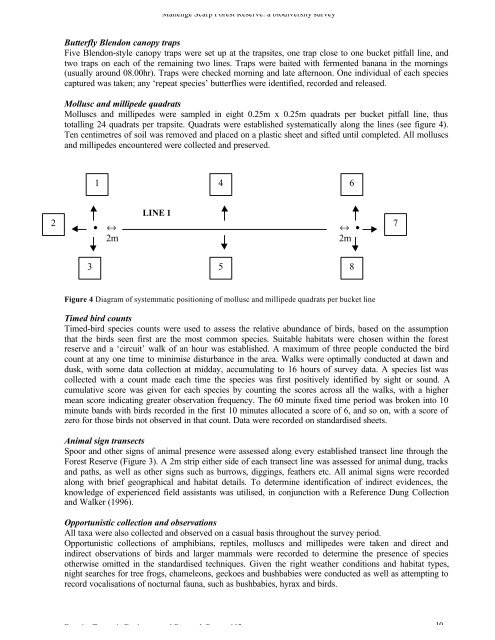Mahenge Scarp Forest Reserve - Frontier-publications.co.uk
Mahenge Scarp Forest Reserve - Frontier-publications.co.uk
Mahenge Scarp Forest Reserve - Frontier-publications.co.uk
You also want an ePaper? Increase the reach of your titles
YUMPU automatically turns print PDFs into web optimized ePapers that Google loves.
<strong>Mahenge</strong> <strong>Scarp</strong> <strong>Forest</strong> <strong>Reserve</strong>: a biodiversity survey<br />
Butterfly Blendon canopy traps<br />
Five Blendon-style canopy traps were set up at the trapsites, one trap close to one bucket pitfall line, and<br />
two traps on each of the remaining two lines. Traps were baited with fermented banana in the mornings<br />
(usually around 08.00hr). Traps were checked morning and late afternoon. One individual of each species<br />
captured was taken; any ‘repeat species’ butterflies were identified, re<strong>co</strong>rded and released.<br />
Mollusc and millipede quadrats<br />
Molluscs and millipedes were sampled in eight 0.25m x 0.25m quadrats per bucket pitfall line, thus<br />
totalling 24 quadrats per trapsite. Quadrats were established systematically along the lines (see figure 4).<br />
Ten centimetres of soil was removed and placed on a plastic sheet and sifted until <strong>co</strong>mpleted. All molluscs<br />
and millipedes en<strong>co</strong>untered were <strong>co</strong>llected and preserved.<br />
1<br />
4<br />
6<br />
2<br />
LINE 1<br />
• ↔ ↔ •<br />
2m<br />
2m<br />
7<br />
3 5<br />
8<br />
Figure 4 Diagram of systemmatic positioning of mollusc and millipede quadrats per bucket line<br />
Timed bird <strong>co</strong>unts<br />
Timed-bird species <strong>co</strong>unts were used to assess the relative abundance of birds, based on the assumption<br />
that the birds seen first are the most <strong>co</strong>mmon species. Suitable habitats were chosen within the forest<br />
reserve and a ‘circuit’ walk of an hour was established. A maximum of three people <strong>co</strong>nducted the bird<br />
<strong>co</strong>unt at any one time to minimise disturbance in the area. Walks were optimally <strong>co</strong>nducted at dawn and<br />
dusk, with some data <strong>co</strong>llection at midday, accumulating to 16 hours of survey data. A species list was<br />
<strong>co</strong>llected with a <strong>co</strong>unt made each time the species was first positively identified by sight or sound. A<br />
cumulative s<strong>co</strong>re was given for each species by <strong>co</strong>unting the s<strong>co</strong>res across all the walks, with a higher<br />
mean s<strong>co</strong>re indicating greater observation frequency. The 60 minute fixed time period was broken into 10<br />
minute bands with birds re<strong>co</strong>rded in the first 10 minutes allocated a s<strong>co</strong>re of 6, and so on, with a s<strong>co</strong>re of<br />
zero for those birds not observed in that <strong>co</strong>unt. Data were re<strong>co</strong>rded on standardised sheets.<br />
Animal sign transects<br />
Spoor and other signs of animal presence were assessed along every established transect line through the<br />
<strong>Forest</strong> <strong>Reserve</strong> (Figure 3). A 2m strip either side of each transect line was assessed for animal dung, tracks<br />
and paths, as well as other signs such as burrows, diggings, feathers etc. All animal signs were re<strong>co</strong>rded<br />
along with brief geographical and habitat details. To determine identification of indirect evidences, the<br />
knowledge of experienced field assistants was utilised, in <strong>co</strong>njunction with a Reference Dung Collection<br />
and Walker (1996).<br />
Opportunistic <strong>co</strong>llection and observations<br />
All taxa were also <strong>co</strong>llected and observed on a casual basis throughout the survey period.<br />
Opportunistic <strong>co</strong>llections of amphibians, reptiles, molluscs and millipedes were taken and direct and<br />
indirect observations of birds and larger mammals were re<strong>co</strong>rded to determine the presence of species<br />
otherwise omitted in the standardised techniques. Given the right weather <strong>co</strong>nditions and habitat types,<br />
night searches for tree frogs, chameleons, geckoes and bushbabies were <strong>co</strong>nducted as well as attempting to<br />
re<strong>co</strong>rd vocalisations of nocturnal fauna, such as bushbabies, hyrax and birds.<br />
<strong>Frontier</strong> Tanzania Environmental Research Report 107 10

















